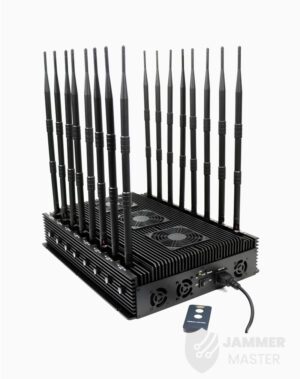
How to Block Drones with a Drone Jammer
In an age where the sky is dotted with drones, the importance of drone jammers has never been more significant. From commercial deliveries to personal

In order to strengthen prison management and enforce strict behavioral restrictions, correctional facilities can now be equipped with dedicated prison signal jammers. These devices serve as crucial tools for law enforcement personnel in maintaining order and security within prisons. The primary objective of prison management is to achieve inmate rehabilitation through humane and personalized approaches. With the installation of these state-of-the-art prison signal jammers, overall management levels in correctional facilities are expected to significantly improve, providing clear advantages in terms of manpower allocation and enhanced security measures.

Handheld Multi-Purpose Signal Blocker Jam 5G/WiFi/GPS/LOJACK/RC JM016
$899.00
High-Power Portable Signal Jammer JM022 Jam Cellular/WiFi/GPS/LoJack
$780.00
24 Antennas Portable 5G Cellular Signal Jammer JM019
$1,150.00
Desktop 5G Cellular Signal Jammer Block Cellular/Wireless/GPS/LoJack JM006
$1,839.99Prior to the installation of prison signal jammers, security personnel were responsible for constant observation and surveillance, with clearly defined roles and responsibilities. However, the introduction of these new signal jammers has eliminated blind spots within the restricted areas, allowing for rotational shifts and providing valuable time for the implementation of more humane management practices. This has effectively reduced the difficulty of enforcing strict control measures, as the signal jammers play a pivotal role in maintaining order and security within the prison environment.
The introduction of dedicated prison signal jammers has revolutionized prison management by significantly improving security measures and facilitating more humane and personalized approaches to inmate rehabilitation. These devices eliminate unauthorized communication within correctional facilities, ensuring a controlled and secure environment. Moreover, the efficient allocation of manpower allows for the implementation of comprehensive rehabilitation programs, ultimately increasing the chances of successful inmate reintegration into society. The utilization of prison signal jammers marks a significant step forward in the pursuit of effective and efficient prison management.
Our frequency checker tool will help you check all frequency bands used in all country.

In an age where the sky is dotted with drones, the importance of drone jammers has never been more significant. From commercial deliveries to personal

Protect your vehicle’s location privacy with a professional guide on GPS jammers. From selection to legal considerations and installation tips, we’ve got you covered. Key

Here’s a step by step guide on how to build your own GPS jammer. Below are the main steps we are going to introduce in

Understanding Signal Blocker: How It Works and Its Applications Signal Blockers are devices that can disrupt mobile phone signals, preventing them from connecting to base

The Application and Benefits of High-Power Signal Jammers Enhancing Signal Blocking Efficiency in Various Environments In today’s technologically advanced world, the need for effective signal

Considerations for Purchasing Exam Room Signal Jammers Ensuring Effective Signal Jamming for Exam Integrity As the year approaches its end, many schools are preparing for

The Importance of Monitoring and Signal Interference Measures During Examinations During examination periods, it is crucial to closely monitor the examination venues and their surrounding

Selecting the Appropriate Cell Phone Jammer for Theaters and Auditoriums Overcoming Challenges in Installation and Maximizing Signal Disruption The Importance of Cell Phone Jamming in

Remote Control of Cell Phone Jammers via Smartphone: A Possibility? With the rapid development of the Internet of Things (IoT), numerous smart home devices have

Supplying high quality signal jamming devices since 2010. The only jammer store you can trust.
Jammer Master © 2024. Premium Signal Jammer Supplier Since 2010.